Shop Solver
For instructions on how to use the Define Commands, please click here.
Define Pattern
Linear by Start Point, End Point and Number of Equally Spaced Points
Linear by Start Point, a Vector and Number of Equally Spaced Points
Linear by Start Point, a Vector, and an Incremental Spacing
Linear by Start Point, a Vector and Successive Increments
A Circle, Start and End Angles and the Number of Points
A Circle, Starting Angle, and Angular Increments
A Circle, Starting Angle, and Number of Increments at an Angular Spacing
2 Previously Defined Linear Patterns
A Linear Pattern, Vector and Number of Columns
A Linear Pattern, Vector, Increment and Number of Columns
A Linear Pattern, Vector, and Increments
Random Pattern
Linear by Start Point, End Point and Number of Equally Spaced Points
PATERN/LINEAR,point1,point2,count
The pattern consists of count equally spaced points between and including point1 and point2.
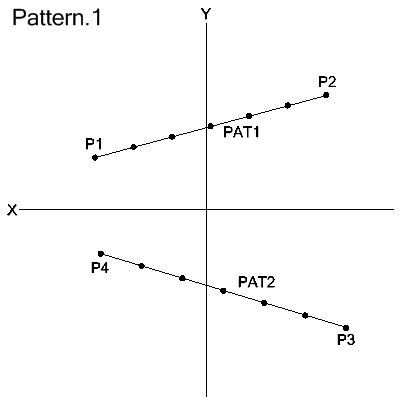
PAT1=PATERN/LINEAR,P1,P2,7
PAT2=PATERN/LINEAR,P3,P4,7
Linear by Start Point, a Vector and Number of Equally Spaced Points
PATERN/LINEAR,point,vector,count
The pattern consists of count equally spaced points. The pattern starts at and includes point. The length and direction of vector determines the spacing between the pattern's points.
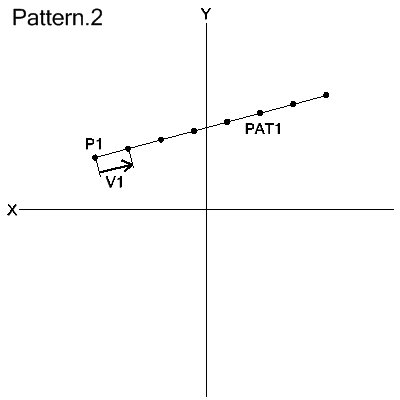
PAT1=PATERN/LINEAR,P1,V1,8
Linear by Start Point, a Vector, and an Incremental Spacing
PATERN/LINEAR,point,vector,INCR,count,AT,distance
The pattern consists of 1 + count equally spaced points. The pattern starts at and includes point. The spacing between the pattern's points is determined by distance. The pattern extends in the direction of vector.
Note: APT supports multiple instances of the phrase
"INCR,count,AT,distance" in this PATERN definition. However, this tool does not currently
support multiple phrases in a single PATERN statement. That
functionality can easily be created via multiple PATERN statements.
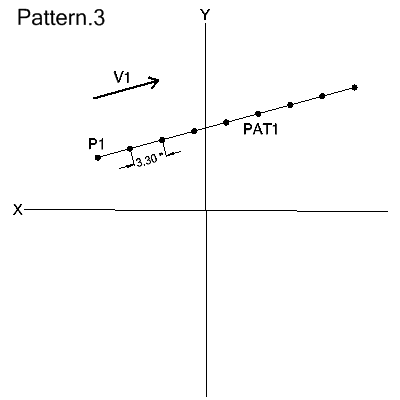
PAT1=PATERN/LINEAR,P1,V1,INCR,8,AT,3.3
Linear by Start Point, a Vector and Successive Increments
PATERN/LINEAR,point,vector,INCR,i1,i2,...in
The pattern begins at point and continues with the given successive increments specified by i1, i2, ... through in. The pattern extends in the direction of vector.
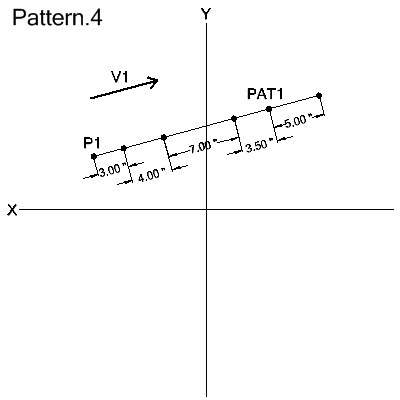
PAT1=PATERN/LINEAR,P1,V1,INCR,3.0,4.0,7.0,3.5,5.0
A Circle, Start and End Angles and the Number of Points
PATERN/ARC,circle,startangle,endangle,modifier,count
modifier: CCLW | CLW
The pattern consists of count equally spaced points on circle. Startangle and endangle are measured in degrees off of the positive X-axis. The points continue in the direction specified by modifier (CCLW for counterclockwise; CLW for clockwise).
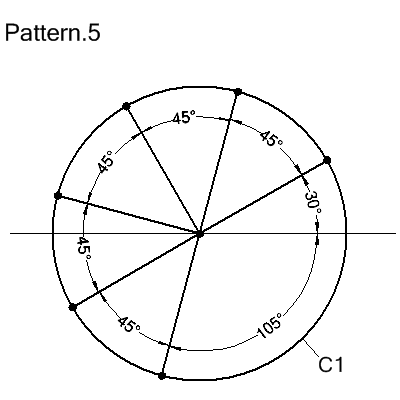
PAT1=PATERN/ARC,C1,30.0,255.0,CCLW,6.0
or
PAT1=PATERN/ARC,C1,255.0,30.0,CLW,6.0
A Circle, Starting Angle, and Angular Increments
PATERN/ARC,circle,startangle,modifier,INCR,a1,a2,...an
modifier: CCLW | CLW
The pattern consists of points on circle in the direction specified by modifier (CCLW for counterclockwise; CLW for clockwise). The pattern begins at startangle measured in degrees off of the positive X-axis. It continues with the given successive angular increments of a1, a2, ... through an.
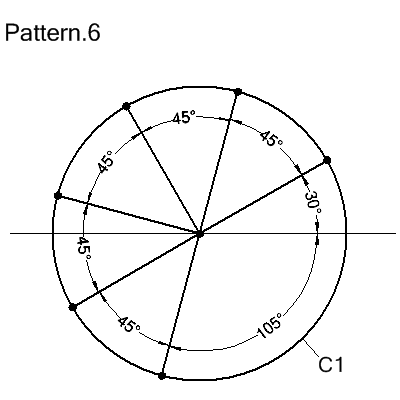
PAT1=PATERN/ARC,C1,30.0,CCLW,INCR,45,45,45,45,45
A Circle, Starting Angle, and Number of Increments at an Angular Spacing
PATERN/ARC,circle,startangle,modifier,INCR,count,AT,angle
modifier: CCLW | CLW
The pattern consists of 1 + count points on circle in the direction specified by modifier (CCLW for counterclockwise; CLW for clockwise). The pattern begins at startangle measured in degrees off of the positive X-axis. It continues for count more points spaced angle degrees apart.
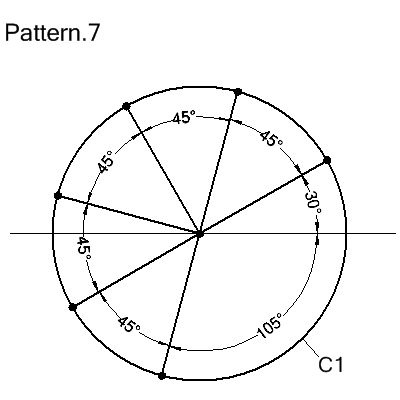
PAT1=PATERN/ARC,C1,30.0,CCLW,INCR,5.0,AT,45.0
2 Previously Defined Linear Patterns
PATERN/PARLEL,pattern1,pattern2
The pattern consists of a parallelogram which is the amalgamation of pattern1 with pattern2.
The first pattern is repeated for each point in the second
pattern. Either the first or last points in both given patterns
must be the same. The points in the finished pattern zig-zag from
row to row (or column to column) in order to minimize cycle time and
distance traveled.
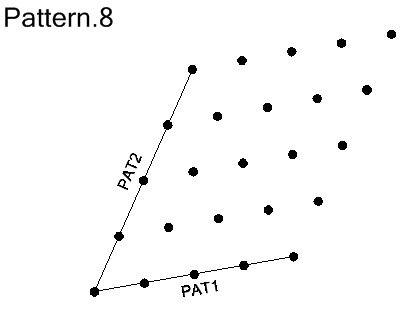
PAT3=PATERN/PARLEL,PAT1,PAT2
A Linear Pattern, Vector and Number of Columns
PATERN/PARLEL,pattern,vector,count
The pattern consists of a parallelogram formed by repeating pattern. The distance and direction of the replication is determined by the length and direction of vector. The finished pattern includes pattern which is then repeated count
- 1 times. The points in the finished pattern zig-zag from
row to row (or column to column) in order to minimize cycle time and
distance traveled.
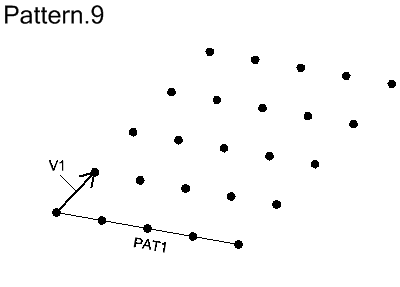
PAT2=PATERN/PARLEL,PAT1,V1,5.0
A Linear Pattern, Vector, Increment and Number of Columns
PATERN/PARLEL,pattern,vector,INCR,count,AT,distance
The pattern consists of a parallelogram formed by repeating pattern. The direction of the replication is determined by the direction of vector. The distance between the repeated patterns is determined by distance. The finished pattern includes pattern which is then repeated count
times. The points in the finished pattern zig-zag from row
to row (or column to column) in order to minimize cycle time and
distance traveled.
Note: APT supports multiple instances of the phrase
"INCR,count,AT,distance" in this PATERN definition. However, this tool does not currently
support multiple phrases in a single PATERN statement. That
functionality can easily be created via multiple PATERN statements.
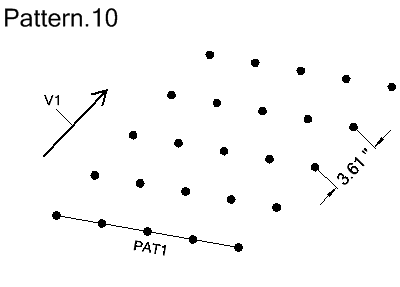
PAT5=PATERN/PARLEL,PAT1,V1,INCR,4.0,AT,3.61
A Linear Pattern, Vector, and Increments
PATERN/PARLEL,pattern,vector,INCR,i1,i2,...in
The pattern consists of a parallelogram formed by repeating pattern. Pattern is repeated in the direction of vector by the successive increment distances of i1, i2,... through in. The points in the finished pattern zig-zag from row
to row (or column to column) in order to minimize cycle time and
distance traveled.
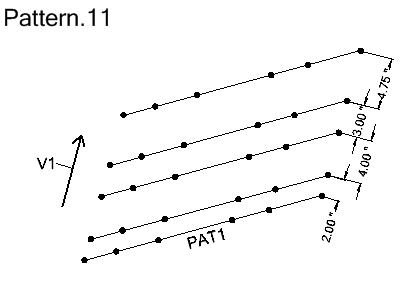
PAT2=PATERN/PARLEL,PAT1,V1,INCR,2.0,4.0,3.0,4.75
Random Pattern
PATERN/RANDOM,pattern1,point1,point2,pattern2,point3,...
The
pattern consists of a collection of previously defined points and/or patterns. The
points in the finished pattern match the order given in the definition.
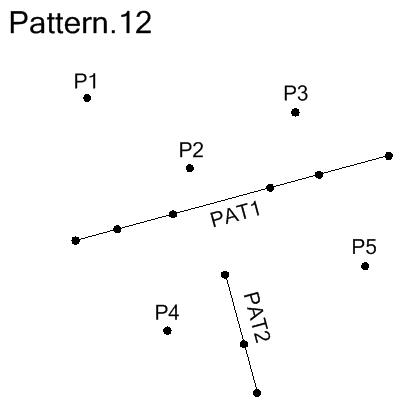
PAT3=PATERN/RANDOM,P1,P2,P3,PAT1,P5,PAT2,P4











